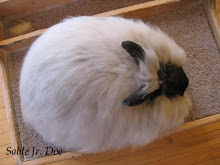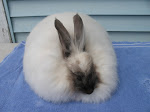-another post from the old blog
There are several kinds of nestboxes available for use with bunny litters, and all have their benefits and drawbacks according to purpose, season, and management style. Here are a few basic types that are easy to find, though there are other choices and a few models that are actually improvised with found materials, etc.
In my barn I use stainless steel nestboxes because I have access to some that are really well made from my meat processor, but I also keep them indoors 24/7 except for bringing them out for feedings, so temperature considerations are not an issue.
The first kind of nestbox that you ordinarily think of when breeding bunnies is all wooden. Years ago these were made of solid wood, but nowadays they are often constructed of plywood, and are easily made at home. The benefit of a wooden nestbox is that it is extremely warm for fall and winter litters, and quite durable if well made. They are relatively inexpensive, especially if made of plywood, and are heavy enough to stay in one place. The disadvantages of wooden boxes is that they are sometimes too hot in the summer (not as practical in warmer areas), and they are difficult to clean thoroughly after litters have lived in them for 3 weeks. The belief used to be that wood did not sanitize as easily as metal, but articles I have read recently indicate that wood DOES perform fairly well in that area, as long as it is cleaned thoroughly in all the nooks and crannies, disinfected, rinsed clean, and left to bleach in the sun whenever possible. Another downside to wood is that many rabbits find it irresistibly chewable, and a box that started out with nice smooth edges in the beginning may end up very jagged and splintery----a potential problem for wool coats.
If you decide to go with wooden nestboxes when first starting to breed, always make sure that the floor is either removable for easy cleaning OR there are good sized holes drilled into the bottom for drainage. One of the biggest dangers to newborn litters is the buildup of bacteria in a nestbox that does not get cleaned often enough and remains damp and moist for days or weeks at a time.
The second most popular type of nestbox is the stainless steel box. Steel boxes are useful in hot climates because they tend to be cooler, and they are extremely easy to clean and disinfect when a litter is finished with them. Most metal nestboxes come with removable floors which makes them easy to disassemble and scrub out, and they also tend to weigh less, which is an issue if you have a large breed with many babies per litter or you move your boxes in and out of the house.
Removable floors tend to be made out of a variety of materials, and there is one company that even sells them with solid metal floors, but that is a poor option because there is no drainage in a situation like that, and the use of it is asking for an immediate buildup of dangerous bacteria. I used to use layers of cardboard and newspaper, etc, in my nestboxes (after removing the original floors first), but the boxes I currently use have pegboard floors, which work wonderfully in terms of staying clean and keeping litters healthy. I used to get crusty eyes now and again with cardboard and other materials, but at this point I put a thick layer of hay on top of the pegboard and that is usually enough to keep everyone clean for 2 weeks along with wool that the doe pulled, and then a clean layer of bedding is added for week 3 which lasts until the box is removed altogether. Eyes are always open all by themselves by day 12, and there is never any dampness in the nest.
Another type of nestbox that is often used is called a 'drop box'. A drop box is a nestbox made of wire that is literally built into the floor of a large doe cage. The biggest advantage to a drop box is that it mimics the natural nesting conditions for a rabbit in the wild (which are underground), and it provides greater than average protection for kits who get pulled out of the nest after feeding because they simply crawl around the wire until they 'drop' back into the box. The disadvantage to this type of nestbox is that it is a permanent feature of the cage, and is thus unremovable without cutting up the floor and patching or replacing it. Another problem is that it cannot usually be used with stacking cages unless there is a wider than average space between each cage and the pan rests lower down beneath it. The best rabbitry setup for drop boxes is the single line of suspended cages such as one would find in a meat operation where does are bred almost constantly and there is no interference with any cages located below or above them.
Other options that people use when expecting litters consist of heavy cardboard boxes (which need to be secured because they tip easily though they can be discarded later), cat boxes and plastic tote boxes (which also need to be secured with wire and tend to retain alot of moisture), and homemade 'above' floor wire boxes. The primary considerations for any nestbox are that it be solid, heavy enough so that the doe cannot tip or flip it over while nesting or jumping in and out, it has excellent drainage, and it is easy to clean. Some boxes have metal or wooden lids on top that partially cover the box for greater privacy and protection from drafts, and others are completely open. Does sometimes have a greater preference for one over the other, so you have to watch your herd and experiment.
So this is a bit about nestbox 'pros and cons' (LOL). If you leave your litters outside all the time and breed over the winter, a wooden box may be the best choice. If you breed for meat and have a large herd operation, a drop box may be ideal. If you keep your boxes inside all the time except for nursing, metal may be the best choice for ease of transport and cleanliness, but everything depends on what your goals are and the kinds of management techniques you employ
Sunday, December 27, 2009
Subscribe to:
Post Comments (Atom)























2 comments:
would you please tell me what color the baby agora is in your hands in the pic i have one just like it but don't know what it is
This is very helpful. Thanks for taking the time to share your knowledge.
Post a Comment